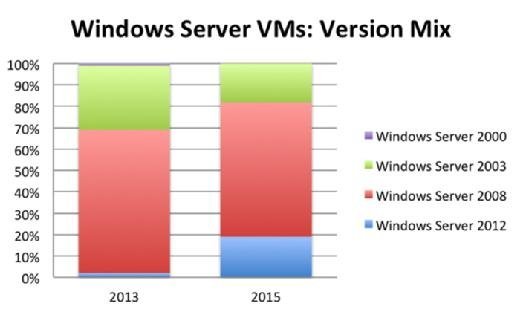
Jakub Jirsk - Fotolia
Windows Server 2003 end of support: Five options to choose from
Support for Microsoft Windows Server 2003 ends in July. Should you upgrade to a newer version of the operating system or choose an alternative?
Microsoft's withdrawal of support for Windows Server 2003 on 14 July is a deadline many IT departments have not been looking forward to.
Industry estimates indicate that upwards of a fifth of servers are still running this version of Windows Server, which has now reached the end of its life as far as Microsoft is concerned.
Organisations will have the option to pay a premium for custom support contracts, but some businesses may find that the option to migrate to a newer operating system (OS) is out of their control
In November 2014, US-Cert issued a warning about the end of support deadline, stating: "Computers running the Windows Server 2003 operating system will continue to work after support ends. However, using unsupported software may increase the risks of viruses and other security threats. Negative consequences could include loss of confidentiality, integrity and/or availability of data, system resources and business assets."
In a report titled Windows Server 2003 end of life: An opportunity to evaluate IT strategy, analyst company IDC warned that organisations could face problems with regulatory compliance if they remain on Windows Server 2003.
"Failure to have a current, supported operating system raises significant concerns about an organisation's ability to meet regulatory compliance requirements, as well as the needs of business units, partners, and customers," the IT research firm noted in its February 2015 report.
Read more about Windows Server 2003 migration
- How to manage risk after support for Windows Server 2003 ends.
- Computer Weekly assesses the risk for organisations that fail to migrate off Windows Server 2003.
- A guide to help enterprises start the Windows Server 2003 migration process and decide on the right upgrade option.
But Windows Server 2003 is still dominant. According to CloudPhysics, which provides big data analytics for datacentres, one in five Windows Server virtual machines (VMs) runs the 2003 version, and thus will be affected by the removal of support.
And while Windows 2003 VM share is declining, given the current rate of decline CloudPhysics estimated that the proportion of servers still running the unsupported OS would reach a statistically insignificant level in the first half of 2018, three years after support ends. "This is a relatively faster decline than Windows 2000, which reached end of life in 2005 but retains a 1% share 10 years later," the firm said.
Extend life of legacy Windows software through virtualisation
According to CloudPhysics, since virtualisation separates PC server hardware from the OS, legacy operating systems can exist for much longer since they are able to run on newer servers.
In a blog post, Krishna Raj Raja, a founding member of CloudPhysics, noted that prior to virtualisation a server refresh generally required an OS refresh. "Newer hardware typically has limited or no support for legacy operating systems, so upgrading the OS became a necessity. With virtualisation, however, the hardware and the OS are decoupled, and therefore OS upgrades are not a necessity," said Raj Raja.
Given that VMware announced support for 64-bit operating systems in 2004, and vSphere supports both 32-bit and 64-bit operating systems simultaneously, there is no need to choose one over the other, according to Raj Raja, with a legacy 32-bit OS (and even 16-bit OS) able to continue to co-exist with newer 64-bit operating systems.
"VMware's support for legacy operating systems is excellent. It is possible to run a legacy OS such as Windows NT on modern processors that Windows NT natively wouldn't even recognise. Also, the virtual devices in VMs provide encapsulation and prevent device driver compatibility issues," said Raj Raja.
Choose Windows Server 2008 for an easier upgrade
Dell Software president John Swainson said some organisations are upgrading to Windows Server 2008 as it is less disruptive than going to Microsoft's newest version, Windows Server 2012 R2.
In a recent interview with Computer Weekly, he said he had seen a number of organisations simply migrate to Windows Server 2008, as it is still a supported operating system and does not require the major application reworking associated with shifting the whole Windows Server infrastructure onto Windows Server 2012.
"Moving to Windows 2012 requires changing applications, and is a far more expensive upgrade from Windows Server 2003," he said.
Ringfence vulnerable systems
In the Gartner paper Managing the risks of running Windows Server 2003 after July 2015, one of the suggestions analyst Carl Claunch made for those systems that cannot be moved is to run a demilitarised zone (DMZ).
"The concept of a demilitarised zone has been frequently used to isolate systems that are accessible by outsiders, to minimise what they could do to the rest of the datacentre if they become compromised. Further, much tighter control can be placed on which other systems they are permitted to contact and the types of access allowed," he wrote.
"This may reduce the usability of a system, but it may be better than the alternative of losing all use if a new vulnerability becomes known. The nature of the vulnerability and the usefulness of the system in that case will help decide whether a DMZ may be sufficient to address risks."
Consider alternative architectures such as Linux
Could Linux be a viable option? Red Hat argues that since organisations moving to Windows Server 2012 would incur considerable costs, assessing the viability of running workloads on Linux should not be discarded.
"If your organisation is running Windows Server 2003, now is the time to carefully consider Linux. If you upgrade to a new Windows infrastructure, 2008 or 2012, you'll incur significant expenses associated with additional licences, client access licences, software licences, migration and future maintenance," claimed Red Hat in its Migrating from Windows to Red Hat Enterprise Linux executive brief.

Move to public cloud
The cloud is another option. Why run a file server on-premise if a cloud service such as Box can be used instead? Application servers may be run more cost effectively on the public cloud.
Certainly, moving to the next supported release of Windows Server is not the only approach an IT department can take. Overall, the end of support for Windows Server 2003 represents an opportunity for CIOs to reassess their legacy Windows server applications and a chance to drop them or re-engineer them to run on a different platform.











